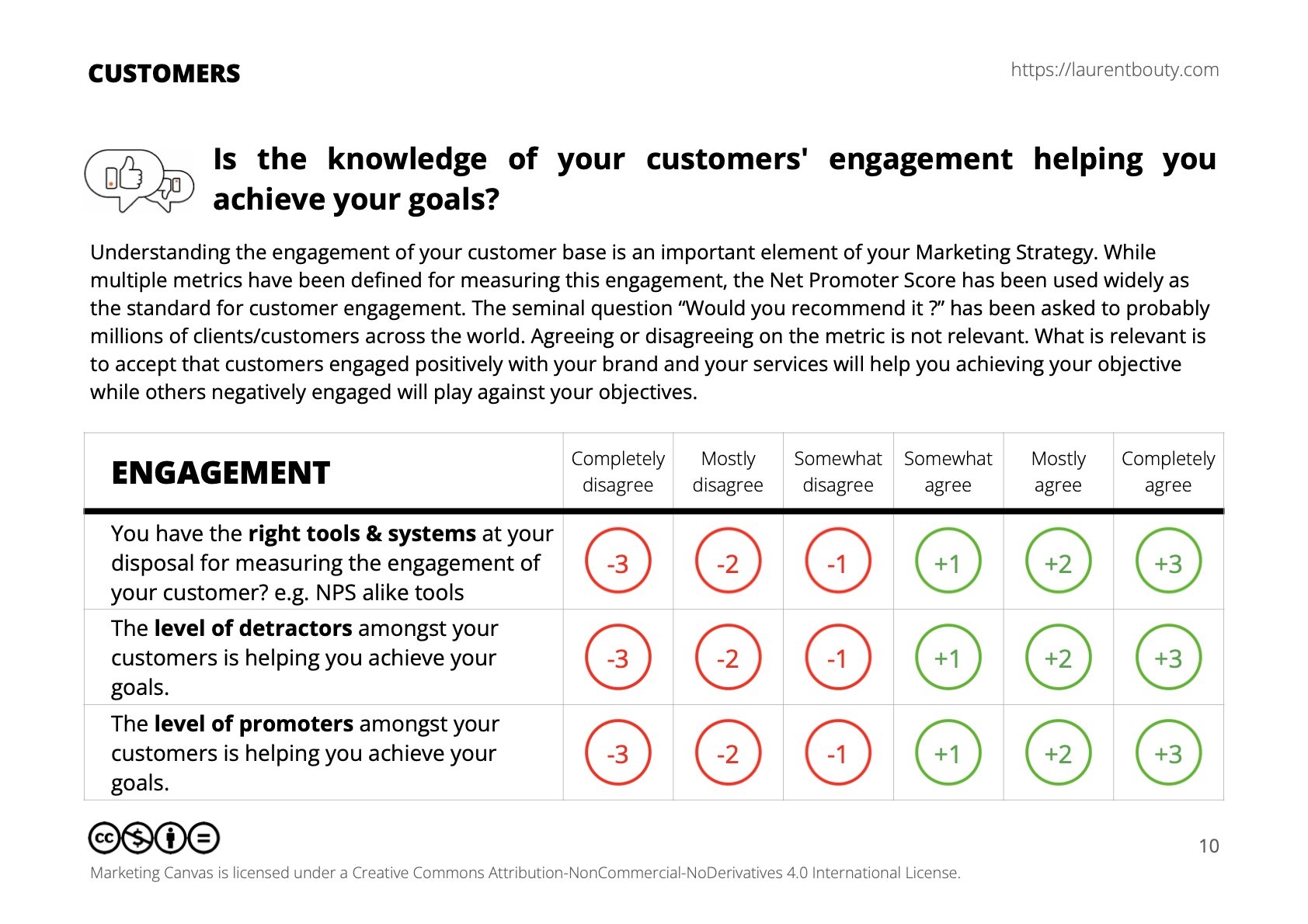Last update: 30/10/2024
In a nutshell
Engagement sub-dimension in the Marketing Canvas focuses on how effectively a business can capture and sustain the interest of its customers. Engagement goes beyond simply attracting attention; it requires creating lasting connections that drive active participation, loyalty, and advocacy. By understanding the factors that influence engagement, companies can design marketing strategies that foster meaningful interactions with their audience.
For example, an eco-friendly cleaning brand like Green Clean might engage customers by sharing content on sustainable living, offering loyalty rewards, or creating a community around environmental responsibility. This level of engagement helps deepen customer relationships and build a strong brand community.
Introduction
Engagement sub-dimension, within the Customer category of the Marketing Canvas, focuses on building and maintaining a connection with customers that drives ongoing interest and involvement. This connection is based on a combination of communication, value delivery, and emotional resonance, which are key to keeping customers engaged over the long term.
While Pains and Gains look at addressing customer frustrations and needs, Engagement emphasizes the importance of continuous, active interaction, aiming to build loyalty and foster a community around the brand.
In the marketing canvas
The Marketing Canvas is a powerful tool for entrepreneurs and non-marketers to build a robust marketing strategy. It consists of six meta-dimensions, each with four sub-dimensions, for a total of 24 sub-dimensions defining your Marketing Strategy. One of these sub-dimensions is “Engagement”, which falls under the CUSTOMER category.
What is engagement?
Engagement represents the emotional and behavioral commitment a customer has with a brand. This commitment might manifest as repeat purchases, sharing positive feedback, participating in brand events, or advocating for the brand. Engaging customers requires understanding their interests, delivering consistent value, and encouraging them to participate in a shared experience with the brand.
For example, Green Clean might engage its eco-conscious customers by:
Providing resources on reducing household waste.
Offering loyalty rewards for repeat purchases of eco-friendly products.
Organizing community events focused on environmental sustainability.
Engagement is essential for building a brand community and transforming customers into advocates.
Engagement: an in-depth perspective
Engagement is about maintaining a two-way interaction between a brand and its customers. It requires businesses to understand what motivates their customers to stay connected and to respond proactively to their interests and feedback.
For example:
Active Engagement: A customer who frequently interacts with Green Clean’s social media content or attends brand-hosted events feels a personal connection with the company’s mission.
Passive Engagement: A customer may use Green Clean’s products without actively engaging with the brand’s content or events. Converting passive engagement into active participation can enhance loyalty and increase brand advocacy.
Understanding the depth and type of customer engagement helps businesses tailor their approaches to meet the specific preferences of their audience.
Tools for engagement: the NPS methodology
The NPS methodology segments customers into three groups based on their level of engagement: Promoters, Passives, and Detractors. Promoters are champions of your brand who will actively recommend your products or services. Detractors, on the other hand, may express dissatisfaction and may discourage others from interacting with your company. Passives fall in-between; they are neither actively promoting nor detracting from your brand.
The usefulness of NPS doesn't stop at categorizing customers. When you compare your NPS score with your competitors', you can gain valuable insights into your brand's standing in the market. This comparison can be achieved through an NPS study of your competitor's customer base or the broader market.
Translating engagement into action
To foster deep and lasting engagement, businesses should prioritize consistent, value-driven interactions that resonate with customer interests. Encouraging feedback, providing valuable resources, and fostering a sense of community can transform passive customers into loyal, actively engaged brand advocates.
Questions to consider:
How do your customers prefer to engage with your brand?
What types of content or interactions resonate most with your audience?
How can you create opportunities for customers to share their experiences and become advocates?
Statements for self-assessment
For a comprehensive evaluation of your understanding and application of the Engagement concept, rate your agreement with the following statements on a scale from -3 (completely disagree) to +3 (completely agree):
You have the right tools & systems at your disposal for measuring the engagement of your customer? e.g. NPS alike tools
The level of detractors amongst your customers is helping you achieve your goals.
The level of promoters amongst your customers is helping you achieve your goals.
You understand the role of sustainability in customer engagement and have aligned your strategies accordingly.
Marketing Canvas Method - Customers - Engagement by Laurent Bouty
Marketing Canvas Method - Customers - Engagement & Sustainability by Laurent Bouty
Interpretation of the scores
Negative scores (-1 to -3): Suggest significant gaps in measuring and managing engagement. Detractors may be impacting your goals negatively, and promoters may not be effectively leveraged. Engagement strategies may lack alignment with sustainability principles.
A score of zero (0): Reflects a functional but under-optimized engagement strategy. While tools and systems may exist, their use may not be systematic or effective, limiting overall impact.
Positive scores (+1 to +3): Indicate a strong engagement strategy. Detractors are addressed effectively, promoters are empowered, and engagement efforts align with sustainability, driving loyalty and advocacy.
Case study: Green Clean’s Engagement strategy
Misaligned understanding (-3, -2, -1): Green Clean lacks the tools to measure engagement and struggles to address customer dissatisfaction. Detractors outnumber promoters, harming the brand’s reputation, while sustainability efforts are absent from its engagement strategy.
Surface understanding (0): Green Clean uses basic tools like surveys but lacks a cohesive approach to managing detractors and empowering promoters. Sustainability is a peripheral concern, limiting its appeal to eco-conscious customers.
Deep understanding (+1, +2, +3): Green Clean leverages NPS and behavioral data to track engagement effectively. It proactively resolves detractor concerns, encourages promoters to share positive reviews, and integrates sustainability into its messaging, fostering strong customer relationships.
Conclusion
The Engagement sub-dimension highlights the importance of measuring and optimizing customer interactions to build loyalty, encourage advocacy, and align with sustainability. A thoughtful engagement strategy ensures that detractors are addressed, promoters are empowered, and the brand remains relevant in an eco-conscious market.
Sources
Harvard Business Review, 2003, https://hbr.org/2003/12/the-one-number-you-need-to-grow
Moving Beyond NPS, Medium, https://link.medium.com/OHO1Mz6IGY
Hubspot, The ultimate guide to your Net Promoter Score (NPS)





































